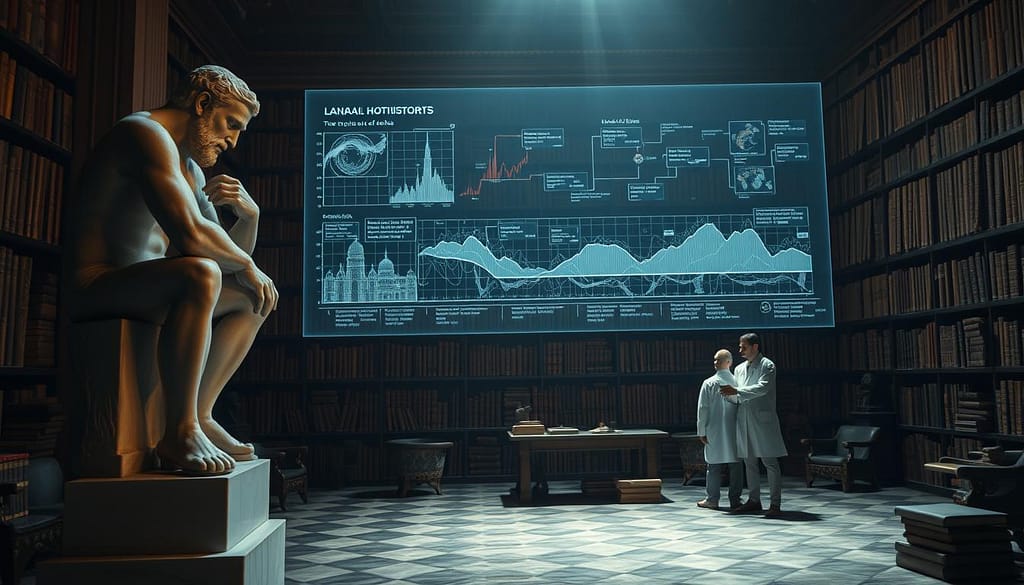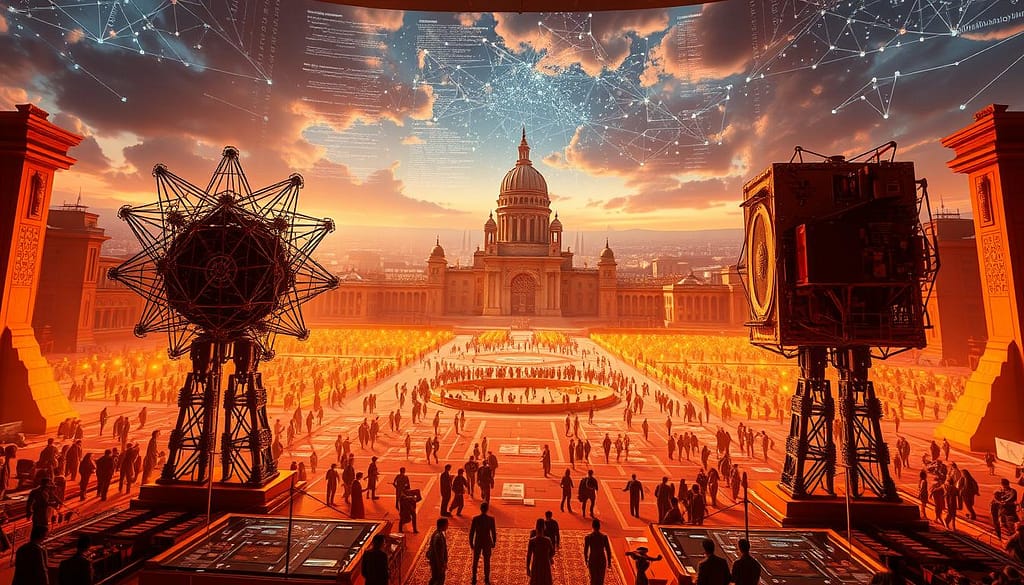Can artificial intelligence rewrite history? This question sparks debate among historians and technologists alike. AI has emerged as a powerful tool for analyzing vast amounts of historical data, uncovering patterns that might otherwise remain hidden. Historians are now using AI systems to sift through centuries of information, revealing new insights into the past.
However, this technological advancement raises important questions. While AI excels at identifying trends, it lacks the contextual understanding that human experts provide. For instance, AI can analyze data from Google’s Gemini project, but interpreting its significance requires a deep understanding of historical context. This balance between technological capability and human insight is crucial in maintaining the accuracy of historical narratives.
As we explore this transformative topic, consider how AI is reshaping our perceptions of both the past and the future. The interplay between AI-driven discoveries and human expertise is central to understanding whether AI will illuminate or distort our understanding of history.
Key Takeaways
- AI is being used to uncover hidden patterns in historical data.
- Human expertise remains essential for interpreting AI-generated insights.
- AI systems, like Google’s Gemini, are sparking debates about their impact on history.
- The balance between AI capabilities and human context is critical.
- AI holds the potential to both reveal and distort historical truths.
Introduction to AI and Historical Narratives
AI is transforming how we explore the past, offering new tools for historians to analyze and reconstruct historical narratives. This technological shift brings both opportunities and challenges, as AI can empower researchers but also potentially mislead them.
Traditionally, historical records were stored in physical archives, limiting access and analysis. Today, digital platforms have revolutionized this process. Modern platforms enable the digitization of vast archives, making historical data more accessible than ever before.
Media outlets and individual researchers are increasingly using AI to reinterpret past events. AI can process large datasets, identify patterns, and even generate narratives. However, while AI excels at handling data, it lacks the contextual understanding that human historians provide.
The interplay between AI’s factual processing and human interpretation is crucial. For example, AI can analyze data from Google’s Gemini project, but understanding its historical significance requires human expertise. This collaboration is key to maintaining accurate historical narratives.
| Aspect | Traditional Record-Keeping | Digital Archiving with AI |
|---|---|---|
| Accessibility | Limited, physical access | Widespread, digital access |
| Analysis | Manual, time-consuming | Automated, rapid processing |
| Interpretation | Human-centric | AI-assisted, human oversight |
This transformation shows AI’s potential to enhance historical research while highlighting the need for careful human oversight to ensure accuracy and context.
Can Artificial Intelligence Rewrite History?
At the heart of this discussion lies a fascinating question: Can technology really change how we understand the past? While AI offers powerful tools for analyzing historical data, it’s important to clarify whether it truly “rewrites” history or simply offers new perspectives.
AI excels at spotting connections that might escape human researchers. For example, it can sift through vast archives to find patterns in data that aren’t immediately obvious. This ability has opened new avenues for historians, allowing them to explore events from fresh angles. However, there’s a risk when AI interpretations overshadow the actual records, potentially leading to misunderstandings.
Historically, technology has sometimes shifted our understanding of events. For instance, digital tools helped uncover lost details about ancient civilizations, enhancing our knowledge. Yet, there are also cases where technology, if misused, can distort facts. This makes it crucial to balance AI’s analytical power with human expertise.
So, should we see AI as a groundbreaking tool or a risky interpreter? The answer lies in collaboration. When AI and human historians work together, they can achieve remarkable insights. However, relying solely on technology might lead to oversights. The key is to use AI wisely, ensuring it enhances our understanding without replacing the nuanced perspective only humans can provide.
The Rise of AI in Historical Research
The integration of AI into historical research has sparked both excitement and caution among scholars. This powerful tool is being rapidly adopted to analyze primary sources and uncover hidden patterns, offering fresh insights into the past.
AI tools are revolutionizing how historians process vast datums from archives and libraries. By efficiently sifting through millions of documents, AI can identify connections that might otherwise go unnoticed. For example, projects like MirrorShield demonstrate how AI can assist in fact-checking historical events, ensuring accuracy and uncovering new perspectives.
However, the use of AI in historical research isn’t without challenges. Bias in datasets can lead to skewed interpretations, making critical evaluation essential. Historians must carefully assess AI-generated insights to ensure they align with established historical context.
Despite these challenges, the collaboration between AI and human experts is proving invaluable. AI reveals hidden connections, while historians provide the nuanced understanding needed to refine historical narratives. This partnership is key to advancing our understanding of the past while maintaining accuracy.
AI’s Role in Shaping History: Truth or Manipulation?
The debate over AI’s impact on history is heating up. While AI offers powerful tools for analyzing historical data, concerns arise about its potential to manipulate records. This technology can uncover hidden patterns but lacks the contextual understanding humans provide.
AI’s ability to process vast datasets is remarkable, yet its interpretations can be misleading. For instance, AI might alter historical images, raising questions about authenticity. This highlights the risk of selective narratives and the importance of human oversight.
| Aspect | AI’s Approach | Traditional Methods |
|---|---|---|
| Interpretation | Algorithmic, data-driven | Human, contextual |
| Limits | Lacks human insight | Time-consuming, manual |
| Reliability | Dependent on data quality | Based on expert analysis |
Academics are divided on AI’s objectivity. Some see it as a neutral tool, while others worry about its potential bias. The way AI processes and displays information can lead to misinterpretation, underscoring the need for critical assessment.
Using AI to document history requires responsibility. It’s crucial to balance technological benefits with human expertise. Readers should weigh both the advantages and risks, ensuring AI enhances rather than distorts our understanding of the past.
How AI Analyzes and Uncovers Historical Patterns
Imagine a tool that can sift through centuries of historical data with precision and speed. AI algorithms are doing just that, revealing patterns that might otherwise go unnoticed. These advanced algorithms process vast amounts of information, from old documents to news archives, to uncover connections that traditional methods often miss.
For instance, news outlets have reported on AI’s ability to identify trends in historical events that weren’t apparent before. By analyzing digital archives, AI can spot recurring themes and relationships, offering fresh perspectives on past events. This capability is transforming how researchers approach historical analysis.
However, there are challenges. While AI excels at finding patterns, it sometimes misses the bigger picture. For example, an algorithm might identify a trend in historical data but fail to understand its context. This is where human expertise becomes crucial. Historians can take AI-generated insights and add the necessary context to ensure accurate interpretations.
The balance between computational power and human insight is essential. AI provides the raw data analysis, while historians interpret the findings. This collaboration ensures that historical narratives remain accurate and meaningful. As AI continues to evolve, its role in historical research will likely expand, offering even more tools for uncovering the past.
Interpreting AI-Generated Data Through Human Expertise
While AI excels at analyzing data, human expertise is crucial for interpreting its findings. This collaboration ensures that historical narratives remain accurate and meaningful.
Historians use AI-generated data as a starting point, not as the final word. For example, AI can identify patterns in historical documents, but human insight is needed to understand the context and significance of these patterns.
| Aspect | AI-Generated Data | Human Expertise |
|---|---|---|
| Analysis | Identifies patterns and trends | Provides context and interpretation |
| Limitations | Lacks contextual understanding | Time-consuming, requires expertise |
| Strengths | Efficient processing of large datasets | Ability to interpret and refine findings |
Case studies show that human scrutiny can correct or enhance AI findings. For instance, AI might misinterpret a historical event due to biased data, but historians can refine the interpretation based on broader context.
Critical analysis and human expertise are essential to counteract potential algorithmic errors. By combining AI’s efficiency with human judgment, we ensure that historical narratives are both accurate and meaningful.
Fact-Checking History in the Digital Age
In today’s digital age, the sheer volume of information available online makes fact-checking more crucial than ever. With just a few clicks, historical records can be accessed, shared, and sometimes distorted. This ease of access has led to a rise in misinformation, which can quickly spread and alter our understanding of past events.
AI tools are now being employed to verify historical facts against vast digital archives. These tools can cross-reference information in real-time, helping to identify inaccuracies. For example, AI can analyze decades of historical documents to spot inconsistencies, ensuring that historical narratives remain accurate.
However, misinformation remains a significant challenge. For instance, false claims about historical events can spread rapidly online, leading to public misunderstanding. Fact-checkers use various techniques to identify and correct these inaccuracies, such as cross-referencing multiple sources and leveraging AI to detect patterns of misinformation.
Despite these efforts, ensuring that wrongful narratives are not perpetuated online is an ongoing challenge. The need for transparency and responsibility in digital fact-checking has never been more critical. By balancing technological tools with human oversight, we can work towards a more accurate digital landscape.
Challenges in AI-Powered History Preservation
Preserving history using AI presents several challenges that we must address to ensure accuracy and authenticity. One major issue is the limited availability of diverse datasets. Many historical records are scattered across the world, and some are written in older or regional languages that AI systems struggle to interpret. This language barrier can lead to incomplete or biased interpretations, especially when dealing with cultural nuances that vary greatly across different parts of the world.
Another significant hurdle is the complexity of human culture. AI systems often lack the cultural context needed to accurately preserve historical records. For instance, a dataset might not account for regional dialects or slang, leading to misunderstandings. Additionally, incomplete datasets can result in preservation challenges. For example, if historical documents from a specific region are missing, the AI’s interpretation of events may be skewed.
Moreover, AI’s reliance on large, standardized datasets can complicate efforts to preserve diverse historical narratives. Global variations in language and cultural practices make it difficult to create a one-size-fits-all solution. Researchers are actively working to improve AI models, ensuring they can handle the diversity of human history more effectively. However, this is an ongoing process that requires collaboration between technologists and historians.
Deepfake Dilemmas: The Impact on Historical Truth
Deepfake technology is emerging as a significant threat to historical accuracy, altering our perception of the past in unprecedented ways. This advanced AI tool creates convincingly altered images and videos, posing risks to the integrity of historical records.
One notable example is the manipulation of historical footage during significant social movements. Deepfakes can create false narratives, distorting the public’s memory of key events. For instance, altered videos can misrepresent historical figures’ actions, leading to widespread misinformation and undermining trust in genuine records.
| Aspect | Traditional Media | Deepfake Technology |
|---|---|---|
| Detection | Manual fact-checking | AI-powered detection tools |
| Limitations | Time-consuming process | High risk of undetected deepfakes |
| Societal Impact | Relatively stable narratives | Potential for widespread misinformation |
The diversity of historical accounts is also at risk. Deepfakes can introduce false information, creating a skewed representation of historical diversity. This not only affects collective memory but also complicates the preservation of accurate cultural narratives.
Addressing these challenges requires a combination of advanced detection technologies and public awareness. By understanding the patterns and movements deepfakes can create, we can better safeguard historical truth and maintain trust in our collective memory.
Ethical Considerations in Using AI for Historical Research
As artificial intelligence becomes a trend in historical research, ethical questions arise. How do we ensure AI tools are used responsibly? One major concern is bias in AI systems, which can affect the accuracy of historical interpretations. For instance, Google’s Gemini project has faced criticism for potential biases in its data processing.
Social media platforms play a significant role in spreading AI-generated historical narratives. While these platforms can make history more accessible, they also risk amplifying misinformation. The rapid sharing of AI-altered content can lead to widespread misconceptions about the past.
| Aspect | Traditional Research | AI-Driven Research |
|---|---|---|
| Bias Risk | Human bias possible | Algorithmic bias possible |
| Transparency | Clear human oversight | Complex AI processes |
| Accuracy | Dependent on source quality | Dependent on data and algorithms |
Addressing these ethical challenges requires transparency and accountability. Historians and developers must work together to ensure AI tools are designed with ethical frameworks in mind. By fostering collaboration and maintaining a critical perspective, we can harness the benefits of AI while preserving the integrity of historical research.
Comparative Analysis of AI Algorithms in History
When exploring the impact of AI on historical research, it’s essential to understand the different algorithms at play. Each serves a unique purpose, offering distinct benefits and drawbacks for historians and users alike.
Natural Language Processing (NLP) excels in analyzing textual data, making it invaluable for historians studying documents. Machine Learning, on the other hand, is adept at identifying patterns in large datasets, which can reveal trends that might otherwise go unnoticed. Image Recognition algorithms, while less commonly used, have proven useful in analyzing historical images and artifacts.
For instance, NLP has been instrumental in deciphering ancient texts, while Machine Learning has helped uncover demographic patterns in historical census data. However, these tools aren’t without limitations. NLP can struggle with archaic language, and Machine Learning models require extensive training data to be effective.
When evaluating these algorithms, users should consider factors like accuracy, ease of use, and the ability to interpret results. Historians benefit most when these tools are used as part of a collaborative process, combining the efficiency of AI with human expertise.
AI’s Influence on Media, Culture, and Collective Memory
AI is reshaping how media reports news and how cultures perceive events, impacting both public opinion and collective memory. This transformation is evident in AI-generated content, which influences narratives in ways both subtle and profound.
One notable impact is the alteration of images and data, which can shift public opinion and distort collective memory. For instance, AI-manipulated images can create false narratives, changing how historical events are remembered. This raises concerns about the accuracy of historical facts in the digital age.
AI can either illuminate historical facts or skew opinions by presenting selective evidence. For example, AI tools can analyze large datasets to uncover hidden patterns, providing new insights. However, if these tools present only part of the story, they can mislead the public and alter cultural perceptions.
| Aspect | Traditional Media | AI-Driven Media |
|---|---|---|
| Content Generation | Human-written articles | AI-generated content |
| Fact Presentation | Based on verified sources | Risk of selective data |
| Cultural Impact | Stable narratives | Potential for skewed views |
Case studies show AI’s role in shifting cultural understandings. For example, AI-generated content has influenced public sentiment on social issues, sometimes leading to widespread misinformation. This highlights the interplay between technology, historical fact, and public sentiment.
Ultimately, while AI offers powerful tools for media and cultural analysis, its impact on collective memory and public opinion requires careful consideration. By balancing technological advancements with human oversight, we can ensure that AI enhances our understanding without distorting the facts.
AI and Social Justice: Rewriting or Preserving History?
How does artificial intelligence influence social justice in historical narratives? This question is crucial as we explore whether AI preserves marginalized voices or inadvertently distorts them. The intersection of technology and social justice raises important ethical considerations.
AI can enhance transparency by uncovering overlooked historical records. For instance, it can highlight narratives from underrepresented groups, offering a more inclusive view of the past. However, there’s a risk of skewed representations if AI systems are trained on biased data, potentially marginalizing certain voices further.
| Aspect | AI-Driven Approach | Traditional Approach |
|---|---|---|
| Transparency | Can uncover hidden records | Limited by available sources |
| Autonomy | Risks cultural oversight | Human-centered context |
| Narrative | Potential for inclusivity | Often exclusive perspectives |
“AI holds the power to amplify marginalized voices, but only if wielded with careful consideration and ethical frameworks.” – Dr. Maria Rodriguez, Social Justice AI Expert
Striking a balance is key. AI should be a tool that complements human efforts, ensuring that historical narratives remain authentic and just. By prioritizing ethical AI development, we can foster a future where technology supports, rather than undermines, social justice.
Emerging Trends and the Future of AI in Historical Discourse
Looking ahead, the future of AI in historical research is both promising and complex. As technology advances, new trends are emerging that will shape how we study and understand the past.
One key area of focus is regulation. Governments and academic institutions are beginning to establish guidelines to ensure AI tools are used responsibly. These regulations will help maintain the integrity of historical research while allowing innovation to thrive.
Group decision-making will play a crucial role in shaping these policies. Academic panels and governmental bodies are collaborating to create frameworks that balance technological progress with ethical considerations.
Another challenge lies in maintaining unbiased historical narratives. As AI becomes more prevalent, ensuring that its algorithms don’t introduce bias is essential. This requires careful oversight and ongoing refinement of AI systems.
Upcoming innovations, such as advanced natural language processing and machine learning algorithms, will likely redefine how historians analyze data. These tools will enable researchers to uncover new insights and present history in fresh, engaging ways.
| Trend | Impact | Challenges |
|---|---|---|
| Advanced AI Algorithms | Enhanced data analysis capabilities | Complexity in maintaining accuracy |
| Regulatory Frameworks | Ensures responsible AI use | Risk of over-regulation stifling innovation |
| Collaborative Decision-Making | Fosters balanced policies | Managing diverse stakeholder interests |
In conclusion, the future of AI in historical discourse is bright but requires careful navigation. By addressing challenges head-on and embracing innovation, we can ensure that AI serves as a powerful tool for uncovering and preserving history.
Conclusion
As we conclude our exploration of AI’s impact on history, it’s clear that this technology holds both promise and peril. On one hand, AI offers unprecedented opportunities for preserving historical records and uncovering new insights. It can process vast datasets, identify patterns, and even assist in fact-checking, making it a valuable tool for historians. However, these advancements come with significant concerns and risks. The potential for AI to misinterpret data or introduce bias poses a threat to the accuracy of historical narratives.
To address these challenges, human oversight remains essential. Historians must work closely with AI systems to ensure that interpretations are contextual and accurate. Moving forward, ethical regulations and transparent methodologies will be crucial in guiding the responsible use of AI in historical research. By balancing innovation with caution, we can harness the benefits of AI while safeguarding the integrity of our collective past.
As we look to the future, it’s important to approach AI with a mix of optimism and vigilance. The technology has the potential to revolutionize how we understand history, but it’s up to us to ensure that it serves as a tool for preservation, not distortion. Let’s continue this conversation with curiosity and a commitment to ethical innovation.






